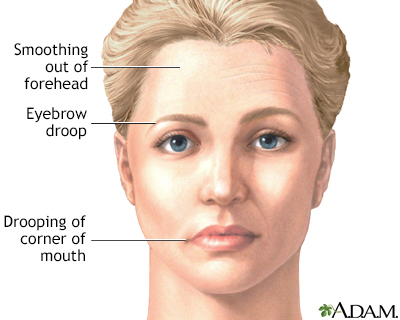Facial paralysis
Definition
Facial paralysis occurs when a person is no longer able to move some or all of the muscles on one or both sides of the face.
Alternative Names
Paralysis of the face
Causes
Facial paralysis is almost always caused by:
- Damage or swelling of the facial nerve, which carries signals from the brain to the muscles of the face
- Damage to the area of the brain that sends signals to the muscles of the face
In people who are otherwise healthy, facial paralysis is often due to Bell palsy. This is a condition in which the facial nerve becomes inflamed.
Stroke may cause facial paralysis. With a stroke, other muscles on one side of the body may also be involved.
Facial paralysis that is due to a brain tumor usually develops slowly. Symptoms can include headaches, seizures, or hearing loss.
In newborns, facial paralysis may be caused by trauma during birth.
Other causes include:
- Infection of the brain or surrounding tissues
- Lyme disease
- Sarcoidosis
- Tumor that presses on the facial nerve
Home Care
Follow your health care provider's instructions on how to take care of yourself at home. Take any medicines as directed.
If the eye cannot fully close, the cornea must be protected from drying out with prescription eye drops or gel.
When to Contact a Medical Professional
Call your provider if you have weakness or numbness in your face. Seek emergency medical help right away if you have these symptoms along with a severe headache, seizure, or blindness.
What to Expect at Your Office Visit
The provider will perform a physical exam and ask questions about your medical history and symptoms, including:
- Are both sides of your face affected?
- Have you recently been sick or injured?
- What other symptoms do you have? For example, drooling, excessive tears from one eye, headaches, seizures, vision problems, weakness, or paralysis.
Tests that may be ordered include:
- Blood tests, including blood sugar, CBC, (ESR), Lyme test
- CT scan of the head
- Electromyography
- MRI of the head
Treatment depends on the cause. Follow your provider's treatment recommendations.
The provider may refer you to a physical, speech, or occupational therapist. If facial paralysis from Bell palsy lasts for more than 6 to 12 months, plastic surgery may be recommended to help the eye close and improve the appearance of the face.
Gallery


References
Mattox DE, Vivas EX. Clinical disorders of the facial nerve. In: Flint PW, Francis HW, Haughey BH, et al, eds. Cummings Otolaryngology: Head & Neck Surgery. 7th ed. Philadelphia, PA: Elsevier; 2021:chap 172.
Meyers SL. Acute facial paralysis. In: Kellerman RD, Rakel DP, eds. Conn's Current Therapy 2021. Philadelphia, PA: Elsevier; 2021:695-696.
Smith G, Shy ME. Peripheral neuropathies. In: Goldman L, Schafer AI, eds. Goldman-Cecil Medicine. 26th ed. Philadelphia, PA: Elsevier; 2020:chap 392.
